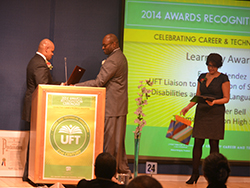
Tag: CTE
2014 CTE Awards Recognition Ceremony – United Federation of Teachers, NYC
LearnKey was pleased to be included this year in the Career and Technical Education (CTE) Recognition Ceremony put on by the United Federation of Teachers (UFT). The UFT is a union of professionals that supports and is committed to strengthening their communities, their profession, and the lives of their members and students. This annual ceremony recognizes teachers that are the very best educators in their particular field of expertise.
This annual event happens around the same time as the Academy Awards, and I now understand why. These teachers, paraprofessionals, guidance counselors, and other professionals are the very best in what they do, just like the actors that get the coveted “Oscar” at the Academy Awards!
These professionals are directly involved with touching a student’s life and helping them realize their goals. Many students that these experts mentor gain meaningful skills and ultimately a real world certification that applies directly to a career. NYC offers many certifications in multiple areas of transportation, the medical sciences, information technologies, graphic design and desktop publishing, and many more that are all recognized on this extraordinary evening.
LearnKey was fortunate enough to be involved with “THE” information technology teacher named Alex Bell. Alex has been teaching computer repair for years and is one of the best teachers in the world as far as getting students certified in CompTIA’s A+ Certification. Alex has been familiar with the LearnKey training for years and will have a big say in how LearnKey will supplement the classroom instruction with hands on projects, lesson plans, labs, and activities that all point to the ultimate goal of certification. Alex has a 100% pass rate and has had for 12 years and that is why we can say “THE”.
LearnKey is a part of a larger business family as well. Better Learning Systems (BLS) is our parent company and “Know Your Talents” is the behavioral arm of our business that assists teachers, counselors, administrators dig down to the behavioral level to see why people do what they do. This “Know Your Talents” tool truly helps individuals figure out what they would truly succeed at in life. Emma Mendez is one of the most extraordinary guidance counselors in NYC who truly focuses on where a student wants to go and helps them realize their dreams. This KYT tool helps counselors assess quickly and with pinpoint accuracy how to steer and guide these wonderful kids down career pathways that fit with their interests and personalities. Emma is truly remarkable and instrumental in helping other guidance counselors all over NYC unlock the potential in every student.
Many students across NYC are so bogged down with “real life” that they need a blessing like Alex and Emma to enter their lives and help them succeed and reach their dreams!
BLS and LearnKey will continue to support the UFT and the CTE programs in New York City Schools.
Thanks Alex and Emma for making us an integral part of this successful equation!!!
Alexander C. Bell – His passion, dedication, and belief that every student can and should be positioned for success is second to none. No one puts in the dedication Mr. Bell does to achieve the pass rates his students achieve every year. Thank you for helping students fulfill their dreams through better learning and providing them with leadership, mentorship, and wonderful guidance.Emelia “Emma” Mendez – Emma demonstrates a vision of leaving “no rock unturned” in seeking resources, learning systems, and passionate people to help create a valued added support system for students so they can achieve their dreams. Thank you for demonstrating that in good will and always reminding everyone: the student comes first.
Applying the Common Core
LearnKey and the Common Core State Standards
Editor’s note: This post is the third part of a three-part a series, in which our Director of Content Development shares his quest to understand one question: Is LearnKey aligned with the Common Core State Standards? (Read part one: In Search of the Common Core and part two: Discovering the Common Core)
Challenges are part of any industry. Sometimes those challenges are overcome, sometimes they prove to be too much, and sometimes a challenge is simply ignored in the hope that it will somehow disappear.
Personally, I love a good challenge.
Many of the challenges I face in my work, through sheer repetition, have become routine—finding an expert, scheduling an expert, acquiring exam objectives, appropriately timing a release, etc. It’s not that these are no longer challenges for me; it’s more that experience has taught me effective mechanisms with which to respond to each.
If you’ve read the two previous blog posts regarding LearnKey and the Common Core State Standards you know that, at least initially, I was hoping to sidestep the challenge of aligning LearnKey courseware to the core standards; I wanted it to “somehow disappear,” I didn’t see it as a good challenge. However, you may have also noticed that while I was trying to dodge this particular challenge I was (perhaps unknowingly) figuring out how to process it into manageable bits. The previous posts, as one commenter noted, were a bit of a tease…you could even argue that this post (so far) is continuing that theme…it is. Yet I felt it was important to show that there was thought and purpose behind what we hope to accomplish as we demonstrate our alignment to the Common Core.
I do not consider myself an educator. I am a technology-minded instructional designer who also happens to be a dreamer. I love research and collaboration. I love to find ways to help people succeed. I love making things better.
This is exactly what aligning LearnKey courseware to the core will do; it will make it better.
So here’s the big reveal; new LearnKey course maps will not only show the course index and corresponding location of exam objectives, they will now indicate which sections of the course align to the Common Core State Standards and offer suggestions on how to apply the course material to satisfy the standard. In addition to the detailed mapping, LearnKey Project Manuals will also indicate how the projects are core aligned.
In the coming weeks LearnKey will release the Photoshop CS6 (4/1), Dreamweaver CS6 (4/15), Premiere CS6 (5/6), and InDesign CS6 (5/20) core mapping documents; followed by Word (6/3), Excel (6/17), and PowerPoint (7/8) (2013 versions). Our new Adobe CC course offerings, coming later this year, will include the updated mapping as part of the project release. The upcoming Photoshop CS6 document shows areas of alignment with the Common Core State Standards in English Language Arts. As more of the maps are generated we will create a “reverse” mapping document—one where the standards are the anchor—that will show all of the courses that can be used to satisfy any particular core standard.
View Common Core State Standards Sample Document
Working to create these mapping documents is a challenge my team and I eagerly accept.
I work with educators on a daily basis. I recognize the frustrations, challenges, and concerns that they face. I know that a map won’t solve every problem, but I do know that it will provide a direction and offer a solution.
Helpful links about the Common Core State Standards:
Discovering The Common Core
LearnKey and the Common Core State Standards
Editor’s note: This post is the second part of a three-part a series, in which our Director of Content Development shares his quest to understand one question: Is LearnKey aligned with the Common Core State Standards? (Read part one: In Search of the Common Core)
I live and breathe exam objectives; whether they are Adobe, CompTIA, Cisco, Microsoft, or others it is part of my job to ensure that our experts and our production team are working from the most recent version of the objectives for any given certification. I am a big fan of efficiency as well, so I don’t like reproducing material unless it is necessary; but I also understand that sometimes a Cisco networking objective and a CompTIA networking objective might not line up 100%. So, in general if we decide to repurpose any existing content we try to keep it within the same certification family.
My first exposure to the Common Core State Standards was from this “objective” perspective, and quite honestly it terrified me. Our sales staff was being asked about our alignment with the core and they approached it from the same direction—how does our existing content meet the objectives of the core? I recall our initial strategy calls all ending with the action of “our courses need to map to the core.” This presented me with a personal quandary; I knew (somehow even before I had actually read the standards) that there was no way I could take an existing LearnKey course and remap it to a new set of objectives. That isn’t how it is done! We only move content around within a certification family—Microsoft within Microsoft, Adobe within Adobe; and here I was being asked to add a different standard—the Core—to my neat and tidy organization. Undoubtedly the objectives for the Core would be in a different order than any of our existing objective standards; the language would be different; the goal would be different.
Honestly, as much value as I knew it would bring, I wasn’t sure I wanted to be a part of the Core.
Flash back to my Saturday repairing a roof with my teacher friend. “What have you read?” he asked. I of course launched into the numerous opinions and responses that I had unearthed. He listened for a moment and then said, “You realize you haven’t actually said anything about the core yet, right?” I stopped. He was right. What I had read was more about the Common Core and not the core standards themselves—of course I had breezed through them, but being blinded by my “objective” perspective I only saw them as having a similar format, structure, and organization to the objectives that I was so familiar with.
I spent a furious evening re-reading the actual standards. There was the answer I was looking for—in numerous places I was reading “Common Core State Standards.” That was the discovery that was looming in front of me the entire time. The Common Core Standards aren’t objectives, at least not in the way I was used to working. We build a course and make sure our experts, assessments, and manuals explain the objectives and give practical experience where possible. They’re bite size pieces that when mixed together yield certification.
The Common Core is a different recipe.
The standards aren’t about understanding a piece of information; they’re about demonstrating ability. It was a simple discovery. To align LearnKey’s content to the Common Core would only require taking larger pieces of our existing material and demonstrate how it shows the ability required by the standard. Instead of forcing a retrofit it would actually bring multiple families of LearnKey content together under one umbrella—the educator has the ability to choose whether they want to use Adobe, or Microsoft, or any of our content to satisfy the same standard…all we have to do is show them which pieces fit where, and that’s what we’re going to do.
(Up next: Applying the Common Core)
Source:
https://www.corestandards.org/the-standards/download-the-standards
In Search of the Common Core
LearnKey and the Common Core State Standards
Editor’s note: This post is introducing a series written by our Director of Content Development, Wyett Ihler. As the Director of Content development, his main responsibilities are to select which course titles LearnKey will be producing during the year, find authors for each course, and assure that we have the most current test objectives from certification vendors. Over the next three weeks Wyett will be writing a three-part series of blogs, sharing what he has learned in his quest to understand one question: Is LearnKey aligned with the Common Core State Standards?
There’s always a bit of adrenaline that accompanies a call from your company’s CEO—that, “Will I be up for whatever will be asked” jolt that comes from seeing his name pop up on the caller ID. He asked what seemed like a perfectly innocuous question, and in retrospect it was, but the simple, “Are we aligned with the Common Core State Standards?” truly lead me down the road less traveled.
I am a parent of two school-aged daughters and I knew some about the Common Core State Standards; I freely admit I didn’t know everything (not even close!), but I had read the literature provided by their school regarding their adoption methods and was satisfied with the information I had. However, when I was asked to assess LearnKey’s level of alignment I found myself telling my CEO that I needed to understand the Core better before making an assessment.
The first step of my search was to find my way through the vast amount of information available regarding the Core. A simple “Common Core” search in Google yields far more results than anyone would have time to sift through. There are a lot of opinions about the Core, and some very passionate responses both for and against, but none of this information was helping me to answer my CEO’s question. Further complicating my search was the fact that in addition to the National Standards, many (I haven’t read enough yet to determine if all) states have state-level implementation standards. On top of the National and State Standards for K-12 there are the technical core standards adopted in many areas and by many LearnKey clients; everywhere I looked there were more standards, more cores and seemingly none of it had anything in common. My search was piling up around me and ultimately leading nowhere.
The second step (yes, I had yet to go beyond step one) was the step that actually set me in the right direction. A chance Saturday meeting with a teacher friend of mine while re-roofing a garage helped me see pass the mountains of data I had so quickly accumulated. We were hauling materials from the truck to the ladder when he asked me how work was going. I grunted, not really wanting to talk about it, and then said that I was working on understanding the Common Core. “Good luck,” he laughed, but then asked more questions about what I was trying to do—and with the practiced patience of a teacher he guided me to the answer that was right in front of me just waiting to be discovered. I was making it too hard; the Core is relatively straightforward and is, in LearnKey’s case, just waiting to be applied.
I sent an email to my CEO the following Monday—it was short and sweet: “The short answer to your question, yes, LearnKey is aligned to the Common Core. However, it might take me a little longer to show you how.”
(Next is Discovering the Common Core)
I ♥ NY

My trip started out with a long day of travel from Las Vegas to New York City. I love New York City and I am sure I will never in my lifetime see everything it has to offer. I am staying in an amazing hotel right next the World Trade Center. You must see this building in person to really appreciate it, my picture is great but does not do it justice. It is so humbling to see in person and to think of all the people we lost on 9/11.
I am here attending a CTE (Career & Technical Education) conference at the United Federation of Teachers. I have learned so much about New York schools and how they looking to helping students better prepare for college and for the workforce.
Tomorrow we are touring the schools who have successfully implemented student certification programs.
CTE Programs Give Students a Reason to Stay in School
Studies show that in California there was a dropout rate of about 30% in the 2004-2005 school year. In 2007 one study showed that 6.2 million students in the United States between the ages of 16 and 24 dropped out of high school; that is almost 17,000 a day.
It is no surprise that the rate is so high, this has been an ongoing issue and the big question is how do we stop this from happening? This is a problem we should all be taking notice of, because over time this will cost the United States a lot of money in lost revenue.
One thing to consider – the same studies and research in California showed that 84% of Career and Technical Education students enrolled in a sequence of courses graduated; that cuts the dropout rate almost in half!
Why do CTE programs work for high school students? One theory is that these programs are engaging and relevant to students lives. Other ideas are that it gives students with other interests a reason to make it to school. Another added benefit is that these programs help students with job readiness and achieving industry certifications. These programs are also key to producing individuals that are meeting the needs of businesses in technology.
Educators – has your school seen similar results? Does your school have an above-average CTE program, or do you know of a school that does?


